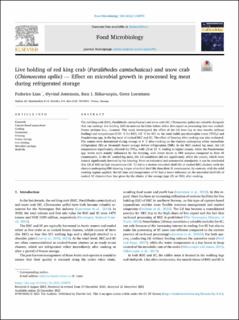Live holding of red king crab (Paralithodes camtschaticus) and snow crab (Chionoecetes opilio) — Effect on microbial growth in processed leg meat during refrigerated storage
Peer reviewed, Journal article
Published version
Permanent lenke
https://hdl.handle.net/11250/2837931Utgivelsesdato
2022Metadata
Vis full innførselSamlinger
- Artikler / Articles [1449]
- Publikasjoner fra CRIStin [2518]
Sammendrag
The red king crab (RKC, Paralithodes camtschaticus) and snow crab (SC, Chionoecetes opilio) are valuable decapods that can undergo live holding (LH) in onshore facilities before either live export or processing into two cooked-frozen sections (i.e., clusters). This study investigated the effect of the LH time (up to two months without feeding) and temperature (5│10 °C for RKC; 1│5 °C for SC) on the total viable psychrotrophic count (TVCP) and Pseudomonas spp. in the leg meat of cooked RKC and SC. The effect of freezing after cooking was also evaluated. The counts were determined during storage at 4 °C after cooking on the clusters undergoing either immediate refrigeration (IR) or 24-month frozen storage before refrigeration (FBR). In the RKC cooked leg meat, the LH temperature significantly affected the TVCP, with LH at 10 °C leading to higher counts, while the Pseudomonas spp. levels were mainly influenced by the freezing, with lower levels in FBR samples compared to their IR counterparts. In the SC cooked leg meat, the LH conditions did not significantly affect the counts, which were instead significantly lowered by the freezing. From an industrial and commercial standpoint, it can be concluded that LH of RKC at high temperature (10 °C) led to a shorter microbial shelf-life of cooked RKC clusters, with the clusters undergoing FBR showing longer microbial shelf-life than their IR counterparts. By contrast, with the mild cooking regime applied, the LH time and temperature of SC had a lower influence on the microbial shelf-life of cooked SC clusters than that given by the choice of the storage type (IR or FBR) after cooking.
